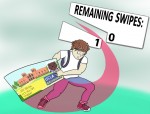To swipe or not to swipe, that is the question.
Bruins may enter the quarter intending to budget their meal plan swipes wisely, but they don’t always succeed. Although some students end the quarter scrounging for a Bruin Plate dinner, others face an opposite problem: a surplus of swipes.
Luckily for them, UCLA Dining Services comes to the rescue, advertising end-of-quarter treats that include boxes of granola bars, trays of macarons and, of course, premium beverages.
However, amid these last-ditch efforts, students have another option for swipes that they often ignore – donating them.
Swipe Out Hunger is a student organization that attempts to address campus food insecurity by collecting students’ unused meal plan swipes through donation drives. The national organization said these swipes are converted into meal vouchers, which can be used at UCLA Dining facilities. Vouchers are administered by the UCLA Economic Crisis Response Team. However, the team has a cap on the amount of meal vouchers it is allowed to provide to students each quarter, largely due to regulations regarding the amount of financial aid resources UCLA can distribute.
But just because there is a cap on vouchers doesn’t give UCLA Dining an excuse to let unused swipes go to waste. Instead of encouraging a leftover swiping spree, swipes should be automatically donated to organizations like Swipe Out Hunger. Once the ECRT cap has been reached, UCLA has the responsibility to create infrastructure that ensures the excess profit from donations goes toward food-insecure students.
Although not all these swipes will be distributed as meal vouchers, there are other ways they can be useful. Profits from donated swipes can be used to better stock the multitude of underwhelming on-campus food pantries, or to provide students with Associated Students UCLA meal vouchers.
Food insecurity is a reality for many Bruins, even if it is one that is rarely publicized. These students don’t just worry about their educational success – they have the added stress of not knowing when they will get their next meal.
According to a 2018 University of California Undergraduate Experience Survey, 37% of UCLA students experienced some level of food insecurity. On a campus with an undergraduate enrollment of approximately 30,000, this daunting statistic clearly requires more attention.
“I feel like a lot of this isn’t talked about on campus, and there are just so many financial issues that nobody talks about,” said Gianna Jimenez, a second-year molecular, cell, and developmental biology student.
It’s senseless for so many unused meals to be recklessly thrown away, especially when swipes disappear into the abyss at the end of the quarter regardless.
Jimenez said she hopes students would be willing to have their unused swipes automatically donated to help their food-insecure peers.
UCLA Dining has the opportunity to make a tangible impact when it comes to food insecurity on campus, and it would not require drastic change.
The Swipe Out Hunger national organization said its Fall 2018 Swipe Drive at UCLA totaled 13,500 donated swipes. And there are around 11,000 students living on the Hill – if most students had even a handful of swipes to donate, the benefits from the increased donations would be immense.
Kathleen Vidanes, a second-year physiological science student, said she usually has around 30 swipes left over and that some of her friends have much more than that.
“I feel like these students paid for (swipes), so it shouldn’t just disappear – it should definitely go towards some kind of purpose,” Vidanes said.
But in order for an influx of swipes to matter, UCLA has the responsibility to create an infrastructure that puts automatically donated swipes to use.
Despite failing to address food insecurity using this untapped potential of extra swipes for years, UCLA Dining insists this is not a problem.
UCLA Dining said unused meal plan swipes are not wasted since those meals are not prepared in the first place, allowing Dining Services to reinvest in food purchasing and keep costs steady for students.
But that logic is inherently flawed. Even though food isn’t being wasted, the value of a swipe is. If Dining Services reinvested in resources to combat food insecurity, students wouldn’t have to worry where their next meal was coming from.
Instead, they’re busy reinvesting in artisan sodas.
Although it is ultimately the choice of students to do as they please when it comes to their meal plans, automatic swipe donations would be easy and effective. Getting the permission of students is necessary of course, but Bruins clearly understand the struggles their fellow students face better than the university does.
As the quarter comes to an end, students on the Hill are prepared to lose the swipes they can’t use before they head home for the summer – but those swipes could help another in need.
To swipe or not to swipe may be the question for most Bruins.
But until UCLA chooses to address food insecurity head on, some students will only have one answer.
